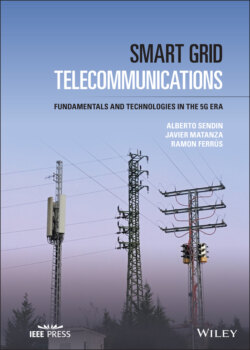Читать книгу Smart Grid Telecommunications - Ramon Ferrús - Страница 22
1.2.2.1.2 Transmission
ОглавлениеPower from Generation is connected to the Transmission part of the grid, with transmission lines that carry electric power at various HV levels. The Transmission grid is the backbone of the electric power system covering long distances to connect large and geographically scattered generation plants to demand hubs where Distribution system starts.
A Transmission system corresponds to a web‐like structure achieving the back‐up of every substation of the grid by all the others. It is a networked, meshed topology connecting generation plants and substations together into a grid that usually is defined at 100 kV or more. The electricity flows over HV transmission lines to a series of substations where the voltage is stepped down by transformers to levels appropriate for Distribution systems.
Transmission power lines are sturdy, durable, and efficient conductors, usually supported by towers. The design of the system needs to be based on mechanical (weight of the conductors, safety distances between conductors, tower and ground depending on the voltage, etc.) and electrical considerations. Transmission lines are typically deployed with three wires along with a ground wire. The conductors are attached to the towers that support them by an assembly of insulators. The towers may support several power lines in the same route, to optimize costs. The system includes sophisticated measurement, protection, and control equipment to prevent its malfunctioning in case of faults (e.g., short‐circuits, lightning, dispatch errors, or equipment failure).
Although not common due to higher costs, in congested areas within cities, underground cables are alternatively used for electric energy transmission. The technology to be used is more sophisticated and applies to the lower voltage ranges. These underground Transmission systems are preferable from the environment perspective.
Although most Transmission systems are AC, a mention needs to be made to DC systems. DC transmission systems require expensive converter stations to convert to the regular AC systems. They are used because they present some advantages (namely, no reactive power flows, higher transmission capacity, lower losses, and lower voltage drops for the same voltage and size of the conductors, controllability of the flow, no frequency dependence, reduced stability problems) over AC Transmission systems in applications such as long distances, submarine cables, and the interconnection systems with different security standards or system frequency.
